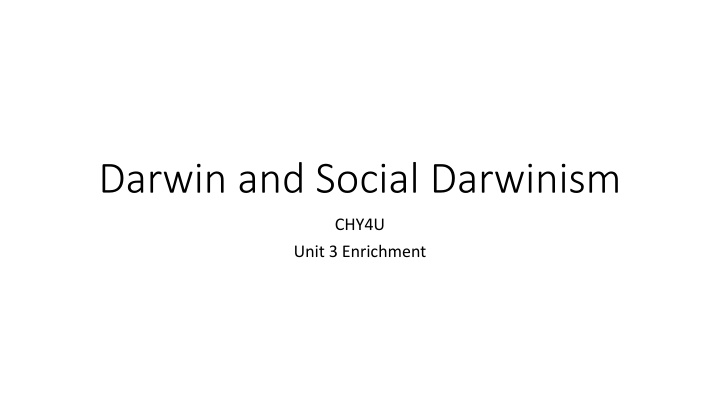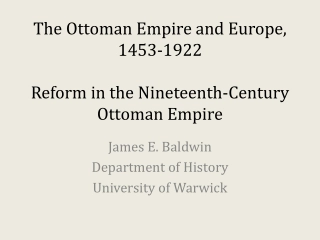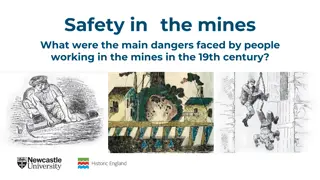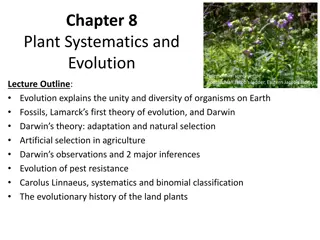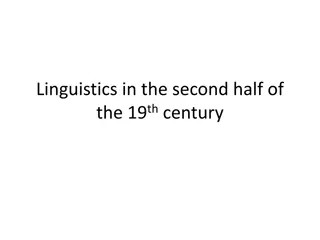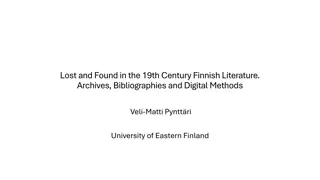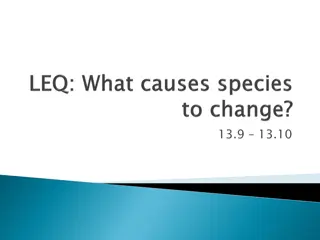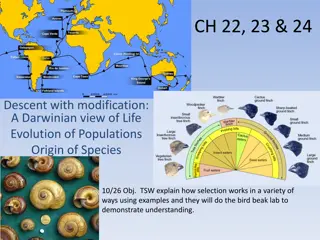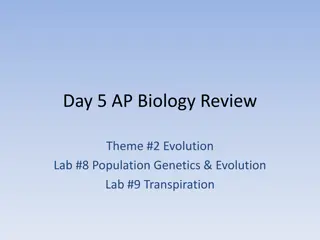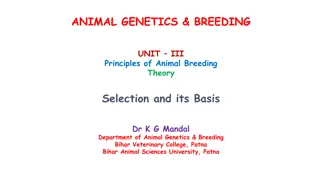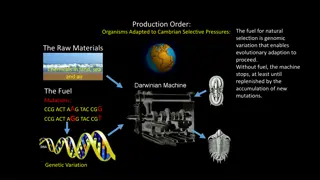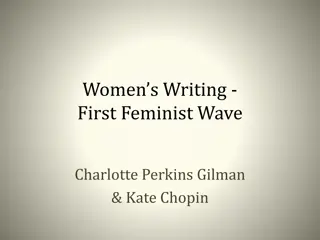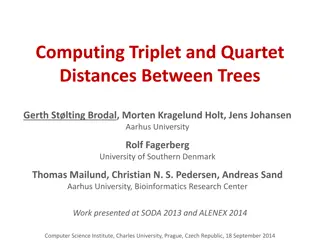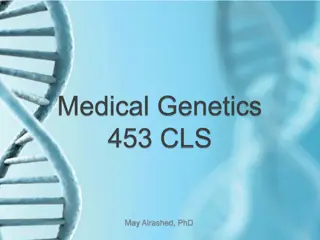Evolutionary Impact: Natural Selection in the 19th Century
Natural selection, as proposed by Charles Darwin in the 19th century, revolutionized views on creation, progress, and adaptation. Darwin's observations of diverse finch species on the Galapagos Islands led to a paradigm shift in understanding how species adapt to different environments. This key moment in scientific history challenged traditional religious perspectives and paved the way for scientific inquiry into the mechanisms of evolution and biodiversity.
Download Presentation

Please find below an Image/Link to download the presentation.
The content on the website is provided AS IS for your information and personal use only. It may not be sold, licensed, or shared on other websites without obtaining consent from the author.If you encounter any issues during the download, it is possible that the publisher has removed the file from their server.
You are allowed to download the files provided on this website for personal or commercial use, subject to the condition that they are used lawfully. All files are the property of their respective owners.
The content on the website is provided AS IS for your information and personal use only. It may not be sold, licensed, or shared on other websites without obtaining consent from the author.
E N D
Presentation Transcript
Darwin and Social Darwinism CHY4U Unit 3 Enrichment
How did natural selection shape views and perspectives of the 19thcentury? Darwin Traditional Thinking Scientific thinking Religious dogma The environment is key Divine creation Change and progress are possible and common Change is not desirable God created everything perfectly
How Darwin Began to Think About Nature and the Environment Differently A Voyage on the Beagle that lasted over five years, 1831-1836.
In 1835 1835 Darwin examined finches (birds) on Galapagos Islands Although the islands were relatively close together, formed by the same rocks, with similar climates, at similar heights the species of finches between the islands were different! Jonathan Clements, Darwin s Notebook: The Life, Times, and Discoveries of Charles Robert Darwin (London: Quid Publishing, 2009), 50.
The most curious fact is the perfect gradation in the size of the beaks in the different species of Geospiza*, from one as large as that of a hawfinch to that of a chaffinch there are no less than six species with insensibly graduated beaks Seeing this gradation and diversity of structure in one small, intimately related group of birds, one might really fancy that from an original paucity [scarcity] of birds in this archipelago, one species had been taken and modified [changed] for different ends. Paul s Birding Diary, http://paulsbirdingdiary.blogspot.ca/2013/03/hawfinch-and-other- garden-birds.html *A type of finch Jonathan Clements, Darwin s Notebook: The Life, Times, and Discoveries of Charles Robert Darwin (London: Quid Publishing, 2009), 65.
It turned out that the finches Darwin saw in the Galapagos Islands were from different species who had each adapted to somewhat different environments. This got him thinking about change in nature. PBS. Evolution Library. Adaptive Radiation Darwin s Finches. 2001. http://www.pbs.org/wgbh/evolution/library/01/6/image_pop/l_016_02.html (Nov. 10, 2011)
How did other scientific developments help Darwin shape views in 19th century England?
Influence of Charles Lyell In 1830, Lyell published Principles of Geology The book argued that slow natural forces, not Biblical forces, affected the earth s formation In particular, the earth s crust shifted. Darwin experienced an earthquake while in Chile and saw the ground rise by eight feet. Pillars showing flood levels from the past. PBS, Evolution, 2001 <http://www.pbs.org/wgbh/evolution/library/02/4/image_pop/l_024_01.html> (April 28, 2008).
Influence of Thomas Malthus In 1838, Malthus saw that the inequalities created by Britain s industrialization were having an effect. The owners become rich through the means of production, while the workers were exploited Through urbanization, cities became more crowded and ordinary people struggled for their daily existence. Population growth would lead to an inevitable shortfall of food (see graph). Humans were in a ceaseless struggle for existence to survive famine, disease and war. This got Darwin thinking about struggle.
These ideas galvanized Darwins thinking about the struggles for survival in the wild, where restraint is unknown. Before reading Malthus, Darwin had thought that living things reproduced just enough individuals to keep population stable. But now he came to realize that, as in human society, populations bred beyond their means, leaving survivors and losers in the effort to exist. PBS, Evolution Darwin and Malthus, 2001 , http://www.pbs.org/wgbh/evolution/library/02/5/1_25_01.html (April 24, 2015).
Social Darwinism How might Darwin s theory of the survival of the fittest be misapplied to various human races?
Social Darwinism: the theory that persons, groups, and races are subject to the same laws of natural selection as Charles Darwin had perceived in plants and animals in nature. Popular in the late 19th and early 20th century The struggle for existence is present between humans in society Survival of the fittest: The cultures of weaker groups would be limited by the power and cultural influence of stronger groups
Darwinism in a social context: sociocultural progress is the product of intergroup conflict and competition the socially elite classes (as those possessing wealth and power) possess biological superiority in the struggle for existence See imperialism case studies.
